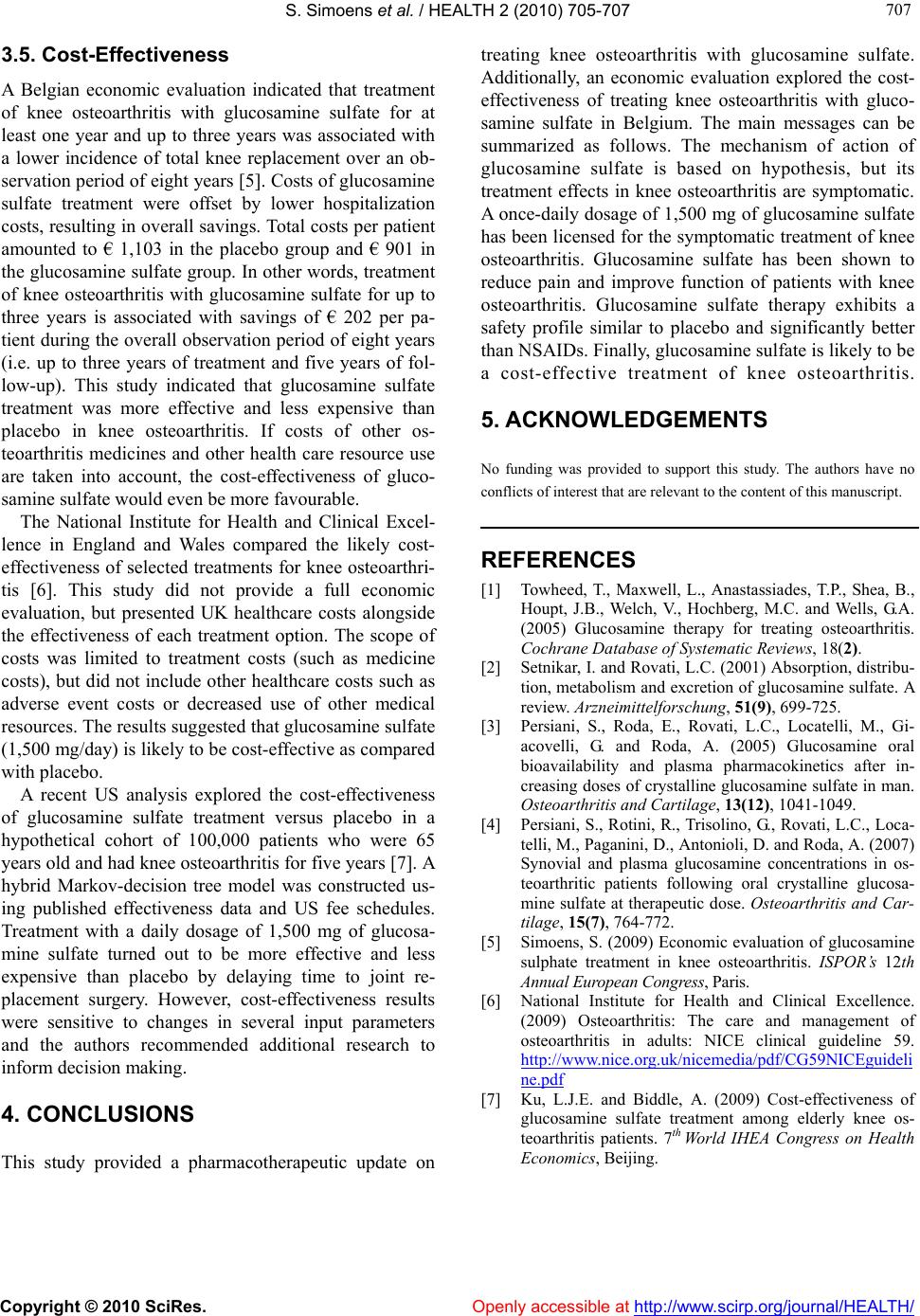
S. Simoens et al. / HEALTH 2 (2010) 705-707
Copyright © 2010 SciRes. http://www.scirp.org/journal/HEALTH/
707
707
3.5. Cost-Effectiveness
A Belgian economic evaluation indicated that treatment
of knee osteoarthritis with glucosamine sulfate for at
least one year and up to three years was associated with
a lower incidence of total knee replacement over an ob-
servation period of eight years [5]. Costs of glucosamine
sulfate treatment were offset by lower hospitalization
costs, resulting in overall savings. To tal costs per patient
amounted to € 1,103 in the placebo group and € 901 in
the glucosamine sulfate group. In other words, treatment
of knee osteoarthritis with glucosamine sulfate for up to
three years is associated with savings of € 202 per pa-
tient during the over all observation period of eight years
(i.e. up to three years of treatment and five years of fol-
low-up). This study indicated that glucosamine sulfate
treatment was more effective and less expensive than
placebo in knee osteoarthritis. If costs of other os-
teoarthritis medicines and other health care resource use
are taken into account, the cost-effectiveness of gluco-
samine sulfate would even be more favourable.
Openly accessible at
The National Institute for Health and Clinical Excel-
lence in England and Wales compared the likely cost-
effectiveness of selected treatments for knee osteoarthri-
tis [6]. This study did not provide a full economic
evaluation, but presented UK healthcare costs alongside
the effectiveness of each treatment option. The scope of
costs was limited to treatment costs (such as medicine
costs), but did not include other healthcare costs such as
adverse event costs or decreased use of other medical
resources. The results suggested that glucosamine sulfate
(1,500 mg/day) is likely to be cost-effective as compared
with placebo.
A recent US analysis explored the cost-effectiveness
of glucosamine sulfate treatment versus placebo in a
hypothetical cohort of 100,000 patients who were 65
years old and had knee osteoarthritis for five years [7]. A
hybrid Markov-decision tree model was constructed us-
ing published effectiveness data and US fee schedules.
Treatment with a daily dosage of 1,500 mg of glucosa-
mine sulfate turned out to be more effective and less
expensive than placebo by delaying time to joint re-
placement surgery. However, cost-effectiveness results
were sensitive to changes in several input parameters
and the authors recommended additional research to
inform decision making.
4. CONCLUSIONS
This study provided a pharmacotherapeutic update on
treating knee osteoarthritis with glucosamine sulfate.
Additionally, an economic evaluation explored the cost-
effectiveness of treating knee osteoarthritis with gluco-
samine sulfate in Belgium. The main messages can be
summarized as follows. The mechanism of action of
glucosamine sulfate is based on hypothesis, but its
treatment effects in knee osteoarthritis are symptomatic.
A once- daily dosage of 1,500 mg of glucosamine sulfate
has been licensed for the symptomatic treatment of knee
osteoarthritis. Glucosamine sulfate has been shown to
reduce pain and improve function of patients with knee
osteoarthritis. Glucosamine sulfate therapy exhibits a
safety profile similar to placebo and significantly better
than NSAIDs. Finally, glucosamine sulfate is likely to be
a cost-effective treatment of knee osteoarthritis.
5. ACKNOWLEDGEMENTS
No funding was provided to support this study. The authors have no
conflicts of interest that are relevant to the content of this manuscript.
REFERENCES
[1] Towheed, T., Maxwell, L., Anastassiades, T.P., Shea, B.,
Houpt, J.B., Welch, V., Hochberg, M.C. and Wells, G.A.
(2005) Glucosamine therapy for treating osteoarthritis.
Cochrane Database of Systematic Reviews, 18(2).
[2] Setnikar, I. and Rovati, L.C. (2001) Absorption, distribu-
tion, metabolism and excretion of glucosamine sulfate. A
review. Arzneimittelforschung, 51(9), 699-725.
[3] Persiani, S., Roda, E., Rovati, L.C., Locatelli, M., Gi-
acovelli, G. and Roda, A. (2005) Glucosamine oral
bioavailability and plasma pharmacokinetics after in-
creasing doses of crystalline glucosamine sulfate in man.
Osteoarthritis and Cartilage, 13(12), 1041-1049.
[4] Persiani, S., Rotini, R., Trisolino, G., Rovati, L.C., Loca-
telli, M., Paganini, D., Antonioli, D. and Roda, A. (2007)
Synovial and plasma glucosamine concentrations in os-
teoarthritic patients following oral crystalline glucosa-
mine sulfate at therapeutic dose. Osteoarthritis and Car-
tilage, 15(7), 764-772.
[5] Simoens, S. (2009) Economic evaluation of glucosamine
sulphate treatment in knee osteoarthritis. ISPOR’s 12th
Annual Eur opean Congress , Paris.
[6] National Institute for Health and Clinical Excellence.
(2009) Osteoarthritis: The care and management of
osteoarthritis in adults: NICE clinical guideline 59.
http://www.nice.org.uk/nicemedia/pdf/CG59NICEguideli
ne.pdf
[7] Ku, L.J.E. and Biddle, A. (2009) Cost-effectiveness of
glucosamine sulfate treatment among elderly knee os-
teoarthritis patients. 7th World IHEA Congress on Health
Economics, Beijing.